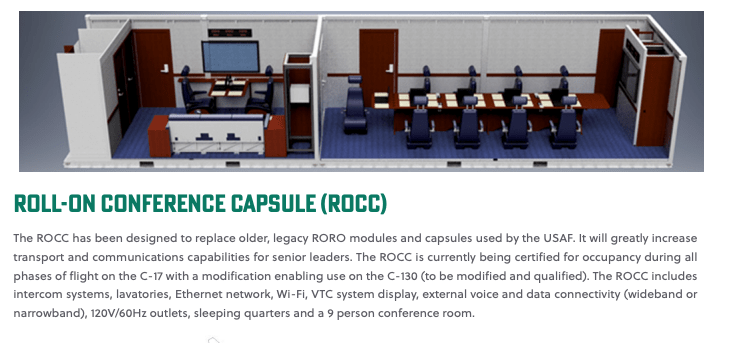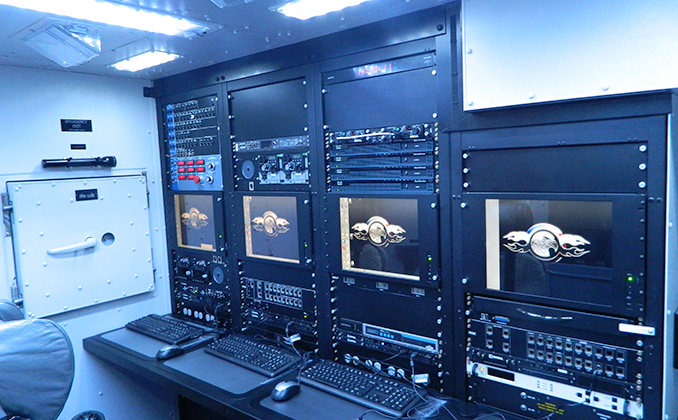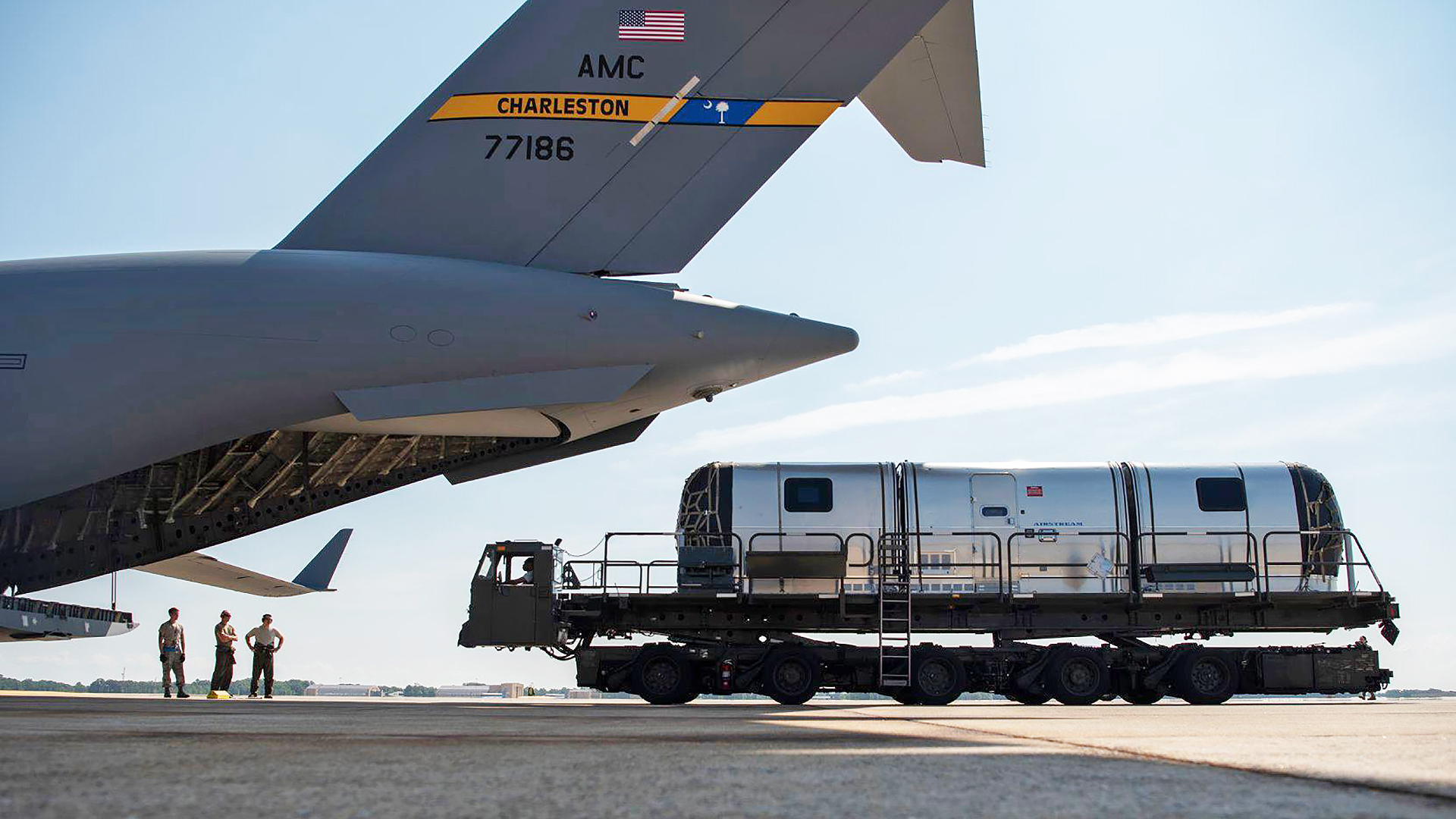For 20 years, the Air Force allowed senior leaders and other VVIPs to travel into some of the most dangerous places on earth aboard converted Airstream trailers stowed aboard C-17A Globemaster III cargo jets that were considered so unsafe they were deemed not airworthy. It wasn’t until 2020 that the flying branch issued a memo authorizing occupancy of the Silver Bullet Command and Control Module, except during takeoffs and landings, refueling and “moderate turbulence in flight as determined by the aircraft commander,” Air Force officials told The War Zone.
The situation was of great enough concern that the House Armed Services Committee in its markup of the Fiscal Year 2023 National Defense Authorization Act asked the Air Force Secretary for a full report on the Silver Bullet’s problems and plan for replacement by next March.

The replacement for the two Silver Bullets, which are still being used, remains a few years away. Testing for the new Roll-On Conference Capsule (ROCC) is slated to start in Fiscal Year 2023, which begins in September, with delivery targeted for Fiscal Year 2025, Air Force Maj. Beau T. Downey, Operations Division Chief at the Air Mobility Command (AMC) Public Affairs Office told The War Zone Wednesday afternoon. So it will be some time before VVIPs traveling overseas on Globemasters will have a new, fully airworthy private, secure module in which they can conduct business, engage in secret communications, and even eat and sleep.
In 2019, the Air Force awarded an $8.5 million contract to SelectTech Services Corp. of Centerville, Ohio, for the design, development, integration, test and delivery of two Roll-On Conference Capsules (ROCC) to replace the old converted Airstream trailers. That was an increase of about $3 million from the initial award, according to Downey.

For years, U.S. cabinet members, service secretaries, and other military leaders, vice presidents, and even celebrities like Robin Williams and Drew Carey spent time flying long distances aboard C-17s in the comfort of the two highly-modified Airstreams. Appropriately dubbed the “Silver Bullet Command and Control Module” (CCM), they are owned by AMC and maintained by the 89th Maintenance Group at Joint Base Andrews, Maryland. The military sometimes uses the C-17 as a chariot of choice because it allows travel into hostile places in a non-descript manner, has an advanced countermeasures and self-defense suite, can maneuver hard if needed and can get into pretty much wherever.
We wrote an extensive profile about the Globemaster’s countermeasures, the CCM and efforts to replace it which you can read here.
Having a quiet, secure place to conduct business in the middle of a noisy, crowded cargo jet is more than a luxury for senior leaders who have to make critical decisions.

The Silver Bullet “was certainly comfortable and provided a relatively quiet place to work and concentrate.” Joseph Votel, the retired Army general who commanded U.S. Central Command from 2016 to 2019, told The War Zone. “As a combatant commander, I had a need to stay in constant communications even during lengthy travel to the Middle East and do it in a place that I could work from. Purpose-designed aircraft and some other capabilities made available to us helped to make that possible — it was a multiplier for me. In the end – I just needed to be able to operate.”

But it’s one thing to use an Airstream on a trip to the Grand Canyon. It’s quite another to strip out the wheels, towing system, fuel tanks, and environmental systems, rebuild the shell to be heavily insulated, integrate an arsenal of communications tech that can connect to it, and turn it into a flying SCIF for some of America’s most important military and civilian leaders traveling the globe, especially to hostile locales.
It turns out that the homey Silver Bullet, complete with wood paneling, cushy reclining leather seats, a small galley, and a sleeping area, had so many problems it was deemed non-airworthy back in 2000.

The War Zone has learned that’s when an independent review by the Air Force Life Cycle Management Center’s (AFLCMC) Engineering Directorate found that the converted Airstream “was not designed to aerospace standards.”
It “did not meet the numerous airworthiness requirements, including crash loads, egress, gusts loads, electrical system design, smoke and fumes, etc.,” Air Force Maj. Hope Cronin told The War Zone.
But that wasn’t the only time the Air Force found problems with the Silver Bullet.
In 2015, the commanders of both AMC and AFLCMC asked the engineering directorate to complete an airworthiness assessment of the Silver Bullet for use on C-17A aircraft to “enable the issuance of a flight authorization allowing its use,” Cronin said.
The assessment “identified numerous risks which were generally associated with substandard electrical system design, improper use of materials for an aircraft environment, and inadequate structural design integrity for crash scenarios, hard landings, and turbulence in flight,” Cronin told The War Zone. “The risk severity was largely driven by failure to apply appropriate airworthiness-related design requirements and verification activities during the design and development of the CCM by the [the Air Force]. This resulted in a substandard design and precluded creation of technical data to demonstrate airworthiness.”
The engineering team evaluated limitations and restrictions that would allow for “acceptable levels of safety for the crew, passengers, and aircraft,” Cronin said. “The limitations and restrictions could only mitigate all risks to Serious (Critical/Occasional) or below.”
The Air Force defines critical as a risk that “could result in one or more of the following: permanent partial disability, injuries or occupational illness that may result in hospitalization of at least three personnel, reversible significant environmental impact, or monetary loss equal to or exceeding $1M but less than $10M.”

It defines occasional as “likely to occur sometime in the life of an item.”
Furthermore, the Air Force found that a lack of the Silver Bullet’s “structural design integrity (crash loads, seat and shelving restraints), electrical system design, and use of substandard materials preclude further mitigation of Airworthiness risk below the Serious level.”
In plain English, that means “given its design shortcomings – the Air Force is assuming ‘serious’ risk in operating the system, even with mitigations in place such as no occupancy during takeoff [and] landing, [aerial refueling] [and] turbulence,” Derek Kaufman, an Air Force Material Command spokesman, told The War Zone. “Thus our desire to field the fully airworthy capability offered by the ROCC.”
It was not until Oct. 6, 2020, that AMC issued a memo authorizing occupancy of the CCM during all phases of the flight except for takeoff and landing, refueling and moderate turbulence in flight, as determined by the aircraft commander.
So why has the Air Force kept the Silver Bullet flying for so long despite its problems?
“The Silver Bullet and associated support equipment fulfills a critical, time-sensitive operational need in permitting U.S. government senior leaders to travel to austere locations where use of executive airlift aircraft may be restricted,” Kaufman told The War Zone Wednesday. “Therefore, we have employed prudent risk mitigation measures for its use. These measures will remain in place to facilitate mission-critical senior leader travel support until the Silver Bullet replacement capability is fielded.”

At his level, Votel said he was “not paying that much attention to any problem” with the Silver Bullet. “I may have heard someone say something about it – but it was nothing that I was focused on at the time. It seemed like an older arrangement that had been around for a while, we used it and it was fine – but so were other approaches that eventually became available to me.”
After about four or five trips to the Middle East aboard C-17s using the Silver Bullet, Votel said travel was eventually switched to other aircraft that could not fit that pod. Today there are a number of options for VVIPs who need to fly in an aircraft equipped with defensive countermeasures and advanced communications suites, including C-40 variants of the 737, C-37 variants of the Gulfstream 5 family, among others. These aircraft have been progressively upgraded with these systems, making them better suited for missions into established air bases that aren’t of the highest threat level.
The new ROCC “is currently being certified for occupancy during all phases of flight on the C-17 with a modification enabling use on the C-130 (to be modified and qualified),” SelectTech Services says on its website.

It includes intercom systems, lavatories, Ethernet network, Wi-Fi, VTC system display, external voice and data connectivity (wideband or narrowband), 120V/60Hz outlets, sleeping quarters and a nine-person conference room.
“Like Silver Bullet, the ROCCs will have a conference room and executive suite that includes a lavatory and bed, which will enable senior leaders and their travel teams to work and rest while en route to their duty destinations,” the Air Force wrote in an article on its website in 2019. “When connected with the Steel Eagle pallet, which provides electrical power and communications capability to the ROCC, occupants will be able to communicate with the outside world during C-17 flight operations.” The Steel Eagle pallet is used to provide secure global communications connectivity for the Silver Bullet today. It sits behind the pod and will be used for its successor, as well, as stated above.
ROCCs will be certified airworthy for personnel occupancy during all phases of flight onboard C-17 aircraft.

“We are very excited to award this contract and to eventually field the Roll-On Conference Capsules,” Lt. Col. Bena Sellers, Materiel Leader in the Mobility and Training Aircraft Directorate’s C-17 Capabilities Branch, said at the time. “The team has been working on a Silver Bullet replacement for a little over three years now starting with defining the ROCC requirements with the customer. We are looking forward to providing senior leaders with an airworthy product that allows them to stay connected, continuing to execute their mission in flight.”
The Roll-On Conference Capsules were expected to be fielded and fully operational by 2022, but that obviously slid to the right.
The good news for VVIPs is that in a few years, they will have a newer, much safer secure capsule to travel into the world’s most dangerous places. And when the ROCC’s introduction finally does happen, the intriguing Silver Bullets could end up being museum pieces, which is probably a better role for them considering the Air Force’s safety concerns.
Contact the author: howard@thewarzone.com
